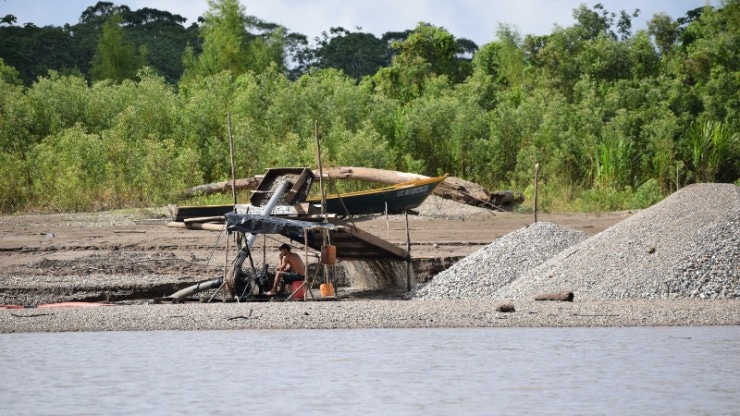Dec 13 2019
A new model developed by researchers from Duke University can estimate the level of mercury being discharged into a local environment. Such discharge is caused by small-scale gold mining and deforestation.
 Small-scale, artisanal mining operations such as the one shown here cause deforestation, which in turn leads to erosion that exacerbates the release of mercury into the local watershed. Image Credit: Duke University.
Small-scale, artisanal mining operations such as the one shown here cause deforestation, which in turn leads to erosion that exacerbates the release of mercury into the local watershed. Image Credit: Duke University.
This latest study can offer ways to reduce the worst impacts of mercury poisoning in areas like those that are already facing increased levels of mercury promoted by gold mining. The study has been recently published in the Environmental Science and Technology journal on December 11th, 2019.
We’ve taken a lot of ground measurements in the Peruvian Amazon of mercury levels in the water, soil and fish. But many areas in the Amazon aren’t easily accessible, and the government often does not have the resources needed to test local sites.
Heileen Hsu-Kim, Professor, Civil and Environmental Engineering, Duke University
“When you clear the land for mining, it leaves behind a landscape that basically went from lush greenery to barren desert,” added Hsu-Kim. “You can easily see the effects in satellite images. If (governments) could use publicly available satellite imagery to identify areas that are likely to be contaminated, it could help them make informed policy decisions to protect public health.”
In the past 20 years, informal and illegal gold mining in Peru’s southern Amazon area of Madre de Dios has increased dramatically. Small-scale operations like these usually involve digging a large pit, cutting down all of the trees in a specific area, and subsequently utilizing mercury to obtain gold from the mined soil.
Once coarse and larger particles are isolated, the remaining fine soil is mixed with mercury and water within a huge drum, quite similar to an oil barrel, and then shaken. The mercury adheres to any gold present in the soil and produces a huge chunk that can be removed easily. On burning this large chunk, mercury is evaporated and discharged into the atmosphere, while pure gold is left behind.
Hsu-Kim informed that apart from discharging mercury into the air, miners usually add as much as three to four times more mercury to every barrel than is actually required. While this process ensures complete extraction of all the gold, it also leaves behind a large quantity of mercury in the slurry.
That mercury is unavoidably thrown back into the mined pit. And since the entire process begins with the clearing of trees, the mercury-rich soil easily ends up into the nearby rivers.
“While the local mercury levels might only double due to the mining itself, the effect of the erosion creates a four-fold increase in the amount of mercury being released into local rivers,” added Hsu-Kim.
This means mining practices can hit people three times with mercury—once from direct contact, once from atmospheric transport and deposition, and once from soil mercury mobilization due to land clearing. The scenarios we run demonstrate that even if mining were to end today, since vegetation is unlikely to return for several decades, the cleared land will continue to release mercury.
William Pan, Elizabeth Brooks Reid and Whitelaw Reid Associate Professor of Population Studies, Duke University
Hsu-Kim and Pan eventually teamed up with Sarah Diringer and Axel Berky, both graduate students, to construct a model to estimate the amount of contaminants, including mercury, discharged into the rivers. The model integrates data from local variables like soil types, annual rainfall, and landscape; a watershed erosion model; and data about deforestation obtained from satellite imagery.
Water and soil samples were also collected from nine locations in the Colorado River watershed located in Madre de Dios. When the researchers studied the mercury content in these samples, they discovered that the new model could precisely predict which regions were likely to experience greater water concentrations of mercury.
The researchers’ model indicates that deforestation has increased the amount of mercury by two-fold in the last 20 years, and this metal enters local water sources in the Colorado River watershed. In the Puquiri subwatershed, deforestation has increased the mercury level by four-fold. The model also indicates that if the present trends of deforestation persist, then the level of mercury being released into the local river systems may rise by 20% to 25% by 2030.
While these findings may appear bleak, the study has shown that the new model certainly works and this fact offers some hope to mitigate the increased mercury levels.
We have shared our model with the Peruvian Ministry of Environment and Ministry of Health. We are working with them to evaluate whether our approach can be used as a tool for developing new policies regarding mining, environmental monitoring of mercury and human exposure.
William Pan, Elizabeth Brooks Reid and Whitelaw Reid Associate Professor of Population Studies, Duke University
The study was funded by the National Institute of Environmental Health Sciences (R21ES026960), the Hunt Oil Company, the Duke Global Health Institute (DGHI) Doctoral Scholars Program, and the U.S. Environmental Protection Agency, Science to Achieve Results (STAR) Fellowship Program (91778701-0).